Subaru EJ engine
| Subaru EJ engine | |
|---|---|
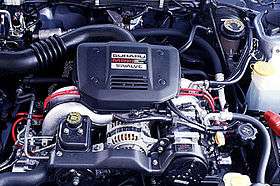 | |
| Overview | |
| Manufacturer | Subaru |
| Production | 1988 – present |
| Combustion chamber | |
| Valvetrain | DOHC/SOHC |
| Combustion | |
| Turbocharger | Optional |
| Fuel type | Petrol/gasoline |
| Chronology | |
| Predecessor | Subaru EA engine |
| Successor | Subaru FB engine |
The Subaru EJ engine is a series of four-stroke automotive engines manufactured by Subaru. They were introduced in 1989, intended to succeed the previous Subaru EA engine. The EJ series is the mainstay of Subaru's engine line, with all engines of this series being 16-valve horizontal flat-fours, with configurations available for single, or double-overhead camshaft arrangements (SOHC or DOHC). Naturally aspirated and turbocharged versions are available, ranging from 96 to 320 horsepower. These engines are commonly used in light aircraft, kit cars and engine swaps into air-cooled Volkswagens, and are also popular as a swap into the wasserboxer engined Volkswagen T3/Vanagon . Primary engineering on the EJ series was done by Masayuki Kodama, Takemasa Yamada and Shuji Sawafuji of Fuji Heavy Industries, Subaru's parent company.
EJ15
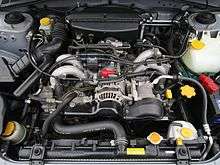
Usage:
- Impreza GC1 series (JDM) - Replaced by Subaru EL engine in 2006 GD, GG, GE & GH series (JDM) Impreza.
- Impreza 93-06 (Latin America)
Specifications
- Displacement: 1,493 cc
- Bore: 85.0 mm
- Stroke: 65.8 mm
- Compression Ratio: 9.4:1 - 10.0
- Valvetrain: SOHC, 16 valves
- Fuel Delivery multi point fuel injection
EJ151
- Horsepower: 97 PS (71 kW; 96 bhp) at 6,000 rpm
- Torque: 129.4 N·m (95 lb·ft) at 3,600 rpm
EJ152
- Horsepower: 102 PS (75 kW; 101 bhp) at 5,600 rpm
- Torque: 136.3 N·m (101 lb·ft) at 4,000 rpm
EJ153
- Horsepower: 95 PS (70 kW; 94 bhp) at 5,200 rpm
- Torque: 140.2 N·m (103 lb·ft) at 3,600 rpm
EJ154
- Horsepower: 100 PS (74 kW; 99 bhp) at 5,200 rpm
- Torque: 142.0 N·m (105 lb·ft) at 4,000 rpm
EJ16
Usage:
- Impreza 93-94 (JDM only) GC4 series
- Impreza 93-06 (Europe & Middle East)
- Impreza 93-97 (Australia)
- Impreza 93-06 (Latin America)
Specifications
- Displacement: 1,597 cc
- Bore: 87.9 mm
- Stroke: 65.8 mm
- Compression Ratio: 9.4:1 - 10.0:1
- Valvetrain: SOHC
- Fuel Delivery mpfi (carburetor in some locations)
EJ16
- Horsepower: 90–98 PS (66–72 kW; 89–97 bhp) at 6,000 rpm
- Torque: 138.3 N·m (102 lb·ft) at 4,500 rpm
EJ18
Usage:
- Impreza 93-99 GC6 series
- Legacy (except USA) 90-96 BC2, BC3, BD2, BD3, BG3 series
- Isuzu Aska (1990–1993)
Specifications
- Displacement: 1820 cc
- Bore: 87.9 mm
- Stroke: 75.0 mm
- Compression Ratio: 9.5:1 - 9.7:1
- Valvetrain: SOHC
- Fuel Delivery single point fuel injection
EJ181
- Horsepower: 110 PS (81 kW; 108 bhp) @ 6000 rpm
- Torque: 149.1 N·m (110 lb·ft) @ 3200 rpm
EJ182
- Horsepower: 115 PS (85 kW; 113 bhp) @ 6000 rpm
- Torque: 154.0 N·m (114 lb·ft) @ 4500 rpm
EJ183
- Horsepower: 120 PS (88 kW; 118 bhp) @ 5600 rpm
- Torque: 163.8 N·m (121 lb·ft) @ 3600 rpm
EJ20
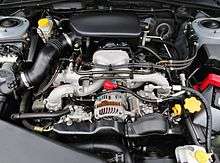
The EJ20 is a 2-liter boxer four, with either single or double overhead camshafts. The smaller EJ18 was developed from the EJ20, as were the enlarged EJ22 and EJ25 engines.
Specifications
- Displacement: 1,994 cc
- Bore: 92.0 mm
- Stroke: 75.0 mm
EJ20E SOHC naturally aspirated
- Legacy JDM
- 1989-1994 125 PS (92 kW) BC - BF series
- 1993-1999 135 PS (99 kW) BD - BG series( ECU code EURO 3G,D3 ; Asia 4H)
- 1998-2004 155 PS (114 kW) BE - BH series( ECU code EURO 3G,D3 ; Asia 4H)
- 2003-2009 140 PS (103 kW) BL - BP series
- Europe
- 1991-1999 115 PS (85 kW) BC, BD, BF series[1]
- Impreza JDM
- 1993-1999 135 PS (99 kW) GC - GF series
- 2008-current 140 PS (103 kW) GH - GE series
- Europe
- 1994-1999 115 PS (85 kW) GC, GF series[2]
- Isuzu Aska (1990–1993)
- 1990-1993 125 PS (92 kW)
EJ20D DOHC naturally aspirated
- Legacy JDM
- 1989-1999 150 PS (110 kW) BC - BF and BD - BG series
EJ202 SOHC naturally aspirated
EJ204 DOHC naturally aspirated AVCS
- Legacy B4 RS JDM BE - BH series
- 1999-2001 190 PS (140 kW)
- Legacy JDM BL - BP series
- 2003-2009 190 PS (140 kW)
- Impreza JDM GC - GF series
- 1993-1999 155 PS (114 kW)
- Impreza GE - GH series
- 2007-2011 150 PS (110 kW)
- Europe
- 2007-2011 150 PS (110 kW)
EJ20N runs on compressed natural gas
EJ20 Turbocharged
All engines listed below were installed with a turbocharger and an intercooler:
EJ20T
This is not actually a valid code from Subaru, but is mostly used by enthusiasts and mechanics to describe the entire line of 2.0 litre turbocharged engines that have been available over time. The practice began with the designation of the USA-spec turbo, commonly referred to as the EJ22T, and the habit of referring to any turbocharged engine as a "T" began. When referring to the EJ20T, one is speaking of one of the following:
EJ20G
EJ20G engines fall into 3 categories:
1. Rocker-style HLA EJ20G usage
- Legacy RS 89-93*Legacy RS-RA 89-93
- Legacy GT 89-93
Power output ranges from 197 bhp (147 kW; 200 PS) @ 6000 rpm and 260 Nm for the GT to 220 PS (162 kW; 217 bhp) @ 6400 rpm and 270 Nm for the RS versions. Engines can be identified by coil on plug, and with 2 M6 bolts per coil and valve covers with 4CAM 16VALVE and horizontal lines above and below the plug holes. All these engines have the air-to-water intercooler setup (chargecooler) and close deck blocks equipped with piston oil squirters.
2. Bucket-style HLA EJ20G usage
- Impreza WRX 92~96.
- Impreza WRX Wagon 92~96
- Subaru Impreza WRX RA 93~96
- EUDM Subaru Impreza Turbo 94~96
This updated type of EJ20G was used in all WRX models since early 1992, cylinder head is equipped with hydraulic lifters compared to the rocker arms used in the previous EJ20G. Pistons in this type of EJ20G are all cast aluminum. Closed-deck engine block equipped with piston oil squirters was used until mid 1994. Followed by Open-deck block equipped with piston oil squirters was used very short period of time, Followed by Open-deck block from 1995 until mid 1996 when the first EJ20K WRX engines came out. The open deck block on all EJ20G could be identified by a smoother surface, and a tab on the right surface of the block halves.
3. Shim-under-bucket style EJ20G usage
All EJ20G equipped Impreza WRX STI/STI RA.
Power output ranges from 220 PS @ 6000 rpm and 260 Nm for the WRX Wagons to 275 PS @ 6500 rpm and 319 Nm for the WRX STI Version II. Engines can be identified by coil on plug with 1 M8 bolt per coil and valve covers with 4CAM 16VALVE and horizontal lines above the plug holes. Generally these engines all have the slanted intercooler. Some engines may not have HLA buckets but solid buckets with shims underneath. These engines also feature lighter valves, the intake valves are marked INKO and the exhaust valves are marked EXKO. The standard HLA valves are I252 and E283 respectively. All WRX Wagon engines and automatic sedan engines came with a TD04 with 90 deg elbow, all manual WRX sedans including STI versions had a TD05 with 90 deg elbow
EJ20K
EJ20K engines fall into 2 categories:
1. Shim-over-bucket style EJ20K usage
- JDM wrx 96~97
- Impreza WRX wagon MT 97~98
- Impreza WRX type RA or R MT 97~98
2. Shim-under-bucket style EJ20K usage
- Impreza wrx sti MT 97~98
- Impreza WRX sti wagon MT 97~98
- Impreza WRX sti type RA or R MT 97~98
Power output is 280 PS @ 6800 RPM for the Japanese versions and 300 PS for the v3 STI with VF23 turbo. These engines can be identified by smooth valve covers, plug leads and a wasted spark coil in the middle of the intake manifold. In addition, the inlet manifold may be bare aluminum for all WRX models and red for all STI models. The engine utilizes an IHI ball-bearing turbo unit. VF22 on the WRX, either a VF23 or VF24 on the STI. These engines have die-cast pistons for all WRX models, STI and STI typeRA/STI type R models shares the exact same factory forged pistons.
EJ205
This engine series is used for WRX models in the world market outside Japan as of 1999. The Japanese WRX models use the EJ207 from 1999~2001, except the 5-door wagon which also uses the EJ205. After 2001, all WRXs use the EJ205, until 2006 when the USDM WRX model changed engines to the EJ255. The EJ205 has an 8:1-9:1 compression ratio.
To identify an EJ205:
- Coil on plug, except in JDM SF5 forester.
- idle air integrated into throttle body
- inlet under manifold
- open deck block
Usage: Impreza WRX
- 99~01 (JDM Wagon Body only)
- 01~current (all JDM)
- 02~05 (USDM)
- 04~05 SAAB 9-2X AERO
- 99~current (all other markets)
Forester Cross Sports, S/tb, STI
- 00-01 (9:1 Compression ratio)
NOTE: The Australian Spec MY00 EJ205 does not have coil on plug but can be identified from the VIN of the vehicle (if known) where the 10th digit will be Y (for year 2000) and the 6th Digit will be 8 (for the 2000yr/EJ205)
EJ207
It started its life for the 9/98-8/99 GC8 in Japan/UK/Australia. The EJ207 has an 8.0:1 compression ratio.
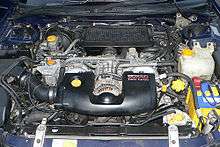
To identify a 9/98-9/2000 EJ207 (v5/v6 WRX STI GC8/GF8)
- wasted spark coil pack off center of manifold
- idle air integrated into throttle body
- inlet under manifold
- red or bare aluminum intake manifold
- Open deck block(2001+ are all Semi-Closed)
- higher rev limit than ej205
- no AVCS
Usage:
- Impreza WRX STi 1998~present (JDM, specifically Homologation models for World Rally Championship)
EJ20X/EJ20Y
Based on the same engine platform; the X designation indicates an automatic package, and the Y designation indicates a manual package. The EJ20X engine was introduced in the 2003 Legacy GT, mated to a five-speed automatic transmission, and the EJ20Y engine was introduced in the 2004 Legacy GT, with a five-speed manual transmission.
The EJ20X and EJ20Y are open deck engines whereby the cylinder walls were supported at the three and nine o’clock positions. It came with an aluminium alloy block with 92.0 mm bores – with cast iron cylinder liners – and a 75.0 mm stroke for a capacity of 1994 cc. with thicker cylinder walls than EJ25 The crankcase for the EJ20X and EJ20Y engines had five main bearings and the flywheel housing was cast with the crankcase for increased rigidity. The EJ20X engine is understood to have a forged crankshaft and connecting rods, but cast aluminium pistons with forged crowns. The EJ20X and EJ20Y engines had an aluminium alloy cylinder head with cross-flow cooling, double overhead camshafts (DOHC) per cylinder bank and four valves per cylinder that were actuated by roller rocker arms.
The EJ20X and EJ20Y engines were the first EJ engines to be equipped with Subaru’s ‘Dual Active Valve Control System’ (‘Dual AVCS’) which provided variable intake and exhaust valve timing. For the BL.I Legacy GT, the EJ20X engine was fitted with a twin-scroll IHI VF38 turbocharger; the EJ20Y engine, however, had a larger twin-scroll Mitsubishi TD04 HLA 19T turbocharger. For the revised BL.II Legacy GT, both the EJ20X and EJ20Y had an IHI VF44 turbocharger for the initial 2006 model year, replaced the following year with the IHI VF45.
Both came with a 9.5:1 compression and a fast spooling turbo yields a torque filled performance. (265-280 bhp)
Turbos:
- IHI VF38 (automatic, 03-06)
- Mitsubishi TD04 HLA 19T (manual, 03-06)
- IHI VF44 (manual and automatic, 06MY only)
- IHI VF45 (manual and automatic, 06-09MY)
Usage: EJ20X/EJ20Y
- 03~09 BL & BP Legacy GT[3]
EJ20TT
This may refer to a 2-liter DOHC Sequential Twin Turbo and intercooled engine (EJ20H/EJ20R/EJ206/EJ208). However, similar to the EJ20T, the term was never used by Subaru. Used from 1994 to 2005 in various iterations listed below. Due to the tight confines of the engine bay, the twin turbo engine was installed in Japanese-spec Legacies only, which were right-hand drive. The Pistons were lighter with a shorter skirt than the WRX EJ20T to allow for higher engine speed.
Specifications
- Displacement: 1,994 cc
- Bore: 92.0 mm
- Stroke: 75.0 mm
- Compression Ratio: 8.5:1 - 9.0:1
- Valvetrain: DOHC
- Fuel Delivery multi-point sequential fuel injection
EJ20H
Usage:
- 1993-1998 Legacy chassis code BD/BG5 JDM RS, RS-B and GT's (183 kW (249 PS; 245 bhp) manual & automatic) and auto RS-B and GT-B's (190 kW (258 PS; 255 bhp) automatic)
EJ20R
Usage:
EJ206
Usage:
- 1998-2003 Legacy chassis code BE5/BH5 JDM GT's, GT-B's and B4's (190 kW (258 PS; 255 bhp)) Transmission: Auto
BH5A - 9.0:1 Compression - "Phase-II", or V5/6 generation.
BH5B - 9.0:1 Compression - "Phase-II", or V5/6 generation.
BH5C - 9.0:1 Compression - "Phase-II", or V5/6 generation.
BH5D - 9.0:1 Compression - "Phase-III", or V7 generation.
EJ208
Usage:
- 1998-2003 Legacy chassis code BE5/BH5 JDM GT's, GT-B's and B4's (206 kW (280 PS; 276 bhp)) Transmission: Manual
BH5A - 8.5:1 Compression - "Phase-II", or V5/6 generation.
BH5B - 8.5:1 Compression - "Phase-II", or V5/6 generation.
BH5C - 9.0:1 Compression - "Phase-II", or V5/6 generation.
BH5D - 9.0:1 Compression - "Phase-III", or V7 generation.
Rev D EJ208's can be considered a totally different motor to the A/B/C's, they run totally different cams, cam pulleys with different timing marks, different crank sprocket with different timing marks, pink 550cc injectors instead of yellow 440's, different intake manifold design. etc.
- A/B have primary VF25 for automatic transmission or VF26 for manual and secondary VF27 turbo's.
- C have primary VF31 and secondary VF32 turbo's.
- D have primary VF33 (46.5 / 35.4 mm 9-blade turbine wheel and a 47.0 mm / 35.4 mm 6 + 6 blade compressor) and secondary VF32 (exhaust side it uses a 46.5 / 35.4 mm 9-blade turbine wheel, teamed with a 52.5 / 36.6 mm 10-blade compressor wheel). All secondary turbos are ball bearing and primary turbos are journal bearing.
EJ22
Usage:
- Impreza 95-01
- Legacy 90-99, Outback 95-96
Specifications
- Displacement: 2212 cc
- Bore: 96.9 mm
- Stroke: 75.0 mm
- Compression Ratio: 9.5:1 - 9.7:1
- Valvetrain: SOHC
- Fuel Delivery multi-point fuel injection
EJ221 Naturally Aspirated
- Horsepower: 135 bhp (101 kW; 137 PS) @ 5800 rpm
- Torque: 137 lb·ft (186 N·m) @ 4800 rpm
EJ222 Naturally Aspirated (1999)
- Horsepower: 142 bhp (106 kW; 144 PS) @ 5600 rpm
- Torque: 149 lb·ft (202 N·m) @ 3600 rpm
EJ22 Enhancements and Improvements
Beginning in the 1997 model year, the 2.2 liter engine for 1997 Legacy and Impreza models had internal and external changes that yield an approximately 10% increase in power and 3% increase in fuel economy. Accomplishing this involves many factors, one of which is engine friction reduction. The pistons were coated with molybdenum to reduce friction. The thin coating reduces moving friction and reduces cylinder wall scuffing. The piston skirt was reshaped and the piston weight was reduced by approximately 100 grams. Compression ratio was increased to 9.7:1 by reshaping the piston crown. This eliminates the clearance that was available between the piston at TDC and the fully opened valve. Piston pin offset has been changed to 0.5mm (0.020 in). Piston to cylinder wall clearance has been reduced by increasing the piston diameter. Another source of high engine friction is the valve train. Hydraulic lash adjusters (HLAs) are always in contact with the valves. The hydraulic pressure of the lash adjuster must be overcome during operation and during the most critical time of engine start. To overcome this situation and to contribute to the total reduction of friction loss, 1997 and later SOHC engines have solid valve adjusters. The scheduled service of this valve train is set at 100,000 miles (160,000 km). SOHC engines now use an adjustment screw to adjust valve clearance. Engines with the earlier HLA are recommended to use 10W30 or 10W40 oil year-round; 5W30 can be used at very low winter temperatures. The roller rocker cam follower system that was introduced on the 1.8L Impreza engines, is installed on all 1996 model year and later 2.2 liter engines. The roller assemblies are not serviceable separately, but the rocker arms may be serviced as individual units. The carbon composition head gaskets with integrated o-rings are interchangeable from left to right on 1990 to 1994 NA engines only. Other Engine Modifications (2.2L 1997): The intake manifold has been reshaped to increase the airflow mass and speed, contributing to improved low and mid engine speed operation. Components located on the intake manifold have been relocated as compared to the 1996 models. EGR Solenoid, Purge Control Solenoid, etc. 1999 2.2 Liter Phase 2 Engine Enhancements (from endwrench article H-4 and H-6 service): All 2.2 liter engine for 1999 are the Phase 2 design. The 2.2 liter Phase 2 engines are a SOHC design, with a newly designed cylinder head. Changes in the 2.2 liter Phase 2 engines are as follows:
- the engine and transmission are fastened with six bolts and two studs.
- the thrust bearing has been moved to the number 5 position.
- the oil groove in the number 1 and 3 have been changed to supply additional lubrication to the crank journal.
Additional Phase 2 Engine Features:
- the cylinder head is a two-rocker shaft, solid type valve system with roller followers.
- the valves are positioned at a larger angle than previous model years. The intake valves are positioned 23 degrees off-center with the exhaust valves positioned 20 degrees off-center. Prior model year engines utilized a 15-degree positioning angle.
- head gasket thickness is 0.7 mm (0.03 in).
- the intake rocker arms are marked so they are correctly placed on the rocker shaft when servicing. An IN1 or IN2 will be embossed on each rocker arm. As viewed from the front of the engine the Number 1 intake valve of each cylinder and the number 2 intake valve have an IN1 marked and IN2 marked rocker arm that mates with it. New IN1 rocker arms can also be identified by a Green painted mark on the top of the rocker arm. The IN2 rocker arms have a white mark. Proper positioning is maintained through the use of a wave washer located between the rocker shaft arm and rocker arm shaft support.
- the camshaft is secured to the cylinder head with the camcase. An oil passage in the cylinder head provides the passageway in the camcase with oil that leads to the intake rocker shaft. Oil from the camshaft is collected on the opposite side of the passageway leading to the intake rocker shaft to provide oil to the exhaust rocker shaft.
Note: Cylinder head and camcase must be replaced together (line bored).
- the sparkplug pipe is pressed into the cylinder head and is not serviceable. If it becomes damaged the cylinder head must be replaced. The seals installed onto the ends of the sparkplug pipes seal against the valve covers and should be replaced when the valve cover is removed.
- pistons on the 2.2 liter engines have a 0.5 mm (0.0 in) offset with the engine having a compression ratio of 10.0 to 1. The horsepower has increased to 142 hp (106 kW) @ 5600 rpm. Maximum torque is 149 lb·ft (202 N·m) @ 3600 rpm.
- camshaft sprockets are constructed of a resin type material with a metal key pressed into the sprocket for maintaining proper sprocket to shaft orientation.
EJ22
2.2 litre
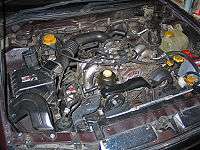
135 bhp (101 kW) @ 5800 rpm 140 lb·ft (190 N·m) @ 4800 rpm Australian model - 100 kW (130 hp) @ 6000 rpm 189 N·m (139 ft·lbf) @ 4800 rpm Usage:
- Legacy 89-99 Brighton and L only after 96[4]
- Impreza 93-97-01
EJ22T
Phase one 2.2 Liter SOHC Turbo, 163 bhp (122 kW; 165 PS) fully closed deck, oil squirters, no intercooler
- Legacy 1991-1994 (North American-spec)
EJ22G
Phase two 2.2 litre closed deck, based on the EJ20K STI engine. Uses identical cylinder heads and turbocharger but with a unique closed deck 2.2L crank case. The pistons are factory forged items, the connecting rods are stock. Although being closed deck, the block does not feature oil squirters for piston cooling, opposed to the EJ20 closed deck block and the USDM-only Legacy EJ22T closed deck block.
- Displacement: 2212 cc
- Bore: 96.9 mm
- Stroke: 75.0 mm
- Compression Ratio: 8.0:1
- Valvetrain: DOHC
- Fuel Delivery multi point fuel injection
- Horsepower: 280 PS (206 kW; 276 bhp) @ 6000 rpm
- Torque: 362.8 N·m (268 lb·ft) @ 3200 rpm
Usage:
- Impreza STi 22B GC8 series (JDM)
EJ25
- Displacement: 2457 cc
- Bore: 99.5 mm
- Stroke: 79.0 mm
- Compression Ratio: 9.5:1 - 10.0:1 Naturally Aspirated
- Compression Ratio: 8.0:1 - 9.5:1 Turbo
- Fuel Delivery EFI
EJ25D
There were two variations of the EJ25D sold in the US market. The engine was introduced in 1996 in the Legacy 2.5GT, LSi, and Legacy Outback. That version of the engine used HLA heads, was recommended to be run on 91 octane fuel, had lower power and torque ratings than the later '97-99 EJ25D, and was only offered with an automatic transmission. In 1997 a revised engine was introduced that used heads with shimmed bucket lifters (versus the HLAs), was designed to run on 87 octane fuel, and was available with either a manual or automatic transmission. Because of the DOHC valve architecture, the spark plugs are more difficult to service in comparison to SOHC variations. The DOHC engines are therefore installed with platinum spark plugs and an extended spark plug service life of 80,000 miles (128,747.5 km).
DOHC (1996) - SAE - 155 hp (116 kW) @ 5600 rpm
140 ft·lbf (190 N·m) at 2800 rpm
DOHC (1997–1999) - SAE - 165 hp (123 kW) @ 5600 rpm
162 ft·lbf (220 N·m) at 4000 rpm
Usage
EJ251
The EJ251SOHC was the first version of a long line of Single Overhead Cam 2.5L engines by Subaru for the US market. The EJ251 was soon replaced by the EJ253 in many models due to its improved cooling to aid in head gasket life and improved engine management and sensors. The EJ251 commonly experienced head gasket failures resulting in interior channel breaches or exterior fluid leaks due to the continued use of a single layer coated gasket first introduced on the EJ25D. Intake volume is calculated by the use of a MAP sensor, unlike the EJ253 which uses a MAF sensor. Compression ratio is 10:1.
Power ISO: 123 kW (165 hp) @ 5600 RPM
226 N·m (167 ft·lbf) @ 4400 rpm
Usage:
- Impreza 2.5RS, 2.5TS 00-03 (US)
- Impreza Outback Sport 00-02, 04 (US)
- Forester 00-04 (US)
- Legacy 00-01 (US, 4EAT)
- Legacy 02-04 (US)
- Outback 00-01 (US, 4EAT)
- Outback 02-04 (US)
- Baja 03-05 (US)
EJ252
SOHC The EJ252 was only briefly used in North America alongside the EJ251 in the USDM Legacy Outback for the 2000 and 2001 Model Years. They are most commonly found in MY00 Legacy Outbacks manufactured before the end of 1999 while MY00 Legacy Outbacks manufactured in 2000 are rarely designated with EJ252 codes in the VIN. While Subaru has not provided a direct list of revisions between the EJ251 and less common EJ252, there is some degree of information suggesting the EJ252 was simply an alternate version of the EJ251 made to meet California Emissions Standards when the SOHC EJ engines were first introduced in North America. Power output has been reported as ISO 115 kW (156 hp) but is often speculated to share the same specs with the largely identical EJ251.[5] From unofficial analysis, the EJ251 shares the same with block, cams, heads, pistons, connecting rods with the EJ252. The only notable differences confirmed are unique intake manifold and throttle body designs to accommodate the different MAP sensor location and IACV location.[5]
Usage:
- Legacy/Outback 00 - 01 (5MT only)
EJ253
SOHC - 165 hp (121 kW) @ 5600/rpm, 167 ft·lbf (226 N·m) torque @ 4400 rpm. Intake volume is regulated by use of a MAF sensor, unlike the EJ251 which is regulated by a MAP sensor. I-Active valves (VVL intake side) on 06+ models which have ISO 173 hp (129 kW) @ 5600 rpm, 166 ft·lbf (225 N·m) torque @ 4000 rpm. Compression ratio 10.0:1
- Impreza 04-08
- Legacy, Outback (North America) 05-11
- Legacy [BL/BP] 03-09 (Europe)
- Legacy [BM/BR] 09-12 (Europe, with 123 kW/167 hp)
- Outback 03-09 (Europe)
- Forester 99 (SF), 05-10 (SG, SH)
- Baja 05+
- Saab 9-2x Linear 05, 06
EJ254
Non Turbo
2005–present - DOHC with 165 hp (123 kW)
Usage:
- Forester 04
- Legacy Lancaster RHD 1999-2003
EJ255
DOHC 16-valve turbo
with sodium-filled valves originally designed for North American market, now sees usage in some European Imprezas and Legacies destined for Australia and South Africa. Power 210-265 hp
EJ255 Version 1: Used in the 2005 and 2006 Legacy, as well as the 2004 and 2005 Forester. This engine uses the AB440 shortblock, which is the same shortblock as the 2004-2006 STI EJ257. The heads on these EJ255 are the AB650s, while the US 04-06 STI is the familiar AB640/910. The cams are the same between the EJ255 Version 1 and the EJ257.
EJ255 Version 2: Used in the 2006-2008 WRX, the 2007+ Legacy, and the 2006+ Forester. This is the newer AIS equipped EJ255, which uses a slightly different AB630 shortblock, as well as the AB820 heads. The only difference in the shortblock of this EJ255 and the 04-06 EJ257 is the pistons. They are of nearly the same construction, but have a slightly larger dish volume. As for the heads, the AB630 heads have a smaller combustion chamber, but I do not yet know the exact specs. I suspect it is around 50ccs based on the engine config spreadsheet listed. Subaru lists the CR at 8.4:1 vs 8.2:1 for the 04-06 STI engine.
Usage in North America:
- Impreza (WRX): 2006–2014
- Forester XT: 2004–2013
- Legacy GT: 2005–2012
- Outback XT: 2005-2009
- Baja XT: 2004 - 2006
- SAAB 9-2X: 2006 only
Usage in the rest of the world:
- Legacy/Outback: 2007–present
- Impreza: 2005–present
- Forester: 2005–2010
EJ257
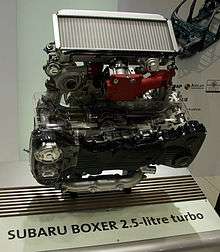
DOHC 16-valve turbo. Originally designed for the North American Impreza STI in 2004 with AVCS and DBW. The same shortblock as EJ255 except the EJ255 has a different dished piston vs the EJ257. The heads also have different components. Subaru of America designates the same part numbers for an EJ255 shortblock, and EJ257 shortblock with the exception of the pistons.
Usage:
- US Market Impreza WRX STi MY04~MY07 (300 hp, 293 hp (New SAE standard))
- US Market Impreza WRX STI MY08~MY16 (305 hp (New SAE standard))
- Asian, European Market Impreza WRX STi 05~present (280 hp, 40 kg/m)
Other Data
All the EJ series share compatibility and construction similarity and are 16 valved engines. The EJ series started with the EJ15, a 1.5 liter (SOHC) and makes ~90 hp, then the EJ16, a 1.6 litre single overhead cam (SOHC). Later followed by the EJ20, a 120 hp 2.0 litre single overhead cam and the EJ22, a 135 hp 2.2 litre single overhead cam. The EJ20 turbocharged version was developed with dual overhead cams, as well as non-turbo DOHC engines and DOHC twin-turbos. The EJ18 and EJ20 were most popular in Europe.
The SOHC EJ Subaru boxer engines were non-interference engines through 1995, run by a single timing belt driving both cams (both sides of the engine) and the water pump. Because they are non-interference engines, if the timing belt fails, the engine of the models up to 1995 will not be destroyed. The oil pump is driven directly from the crank shaft and the waterpump by the timing belt. All DOHC and 1998-up SOHC EJ engines are interference engines, if the timing belt fails the engine will likely be destroyed or the valves & piston will be heavily damaged.
All Subaru EJ engines have a 1-3-2-4 firing order.
Some of the 2005 and later Subaru vehicle Engines (especially the turbo charged engines) are using CAN bus as their sole Vehicle/Vessel speed input channel. When those ABS Speed signal are removed, the ECU will force the Engine to run in limp home mode. This has posed some challenge for people who try to use the same automotive boxer 2.5L and 3.3L engines on Aerospace application, engine replacement for aged Subaru vehicles, and VW Vanagon modifications, etc.
The following table has details on a few of the commonly modified Subaru engines:
| Block | EJ205 | EJ207 | EJ255 | EJ257 | EJ257 |
|---|---|---|---|---|---|
| Head Type | US WRX | SpecC | US WRX | US STI | EU STI |
| Bore (mm) | 92.0 | 92.0 | 99.5 | 99.5 | 99.5 |
| Crank Stroke (mm) | 75 | 75 | 79 | 79 | 79 |
| Rod Length (mm) | 130.43 | 130.43 | 130.43 | 130.43 | 130.43 |
| Piston Pin Offset (mm) | .3289 | .3159 | .3088 | .3088 | .3088 |
| Deck Height (mm) | 201 | 201 | 201 | 201 | 201 |
| Gasket Thickness (mm) | 0.8 | 0.8 | 0.8 | 0.8 | 0.8 |
| Head Volume (cc) | 51 | 50 | 51 | 57 | 50 |
| Piston Dish (cc) | 12 | 8 | 24 | 22 | 22 |
| Piston Deck (mm) | 0.38 | 1.48 | 0.39 | 0.39 | 0.39 |
| Total Quench Height (mm) | 0.98 | 2.08 | 0.99 | 0.99 | 0.99 |
| Total Quench Volume (cc) | 8.51 | 13.83 | 7.70 | 7.70 | 7.70 |
| Total Deck Volume | 18.51 | 19.83 | 29.70 | 29.70 | 29.70 |
| Swept Volume (cc) | 498.57 | 498.57 | 614.25 | 614.25 | 614.25 |
| Compresses Volume (cc) | 89.51 | 89.83 | 85.31 | 83.00 | 79.70 |
| Static Compression Ratio | 8.17:1 | 8.14:1 | 8.2:1 | 8.4:1 | 8.71:1 |
| Rod to Stroke Ratio | 1.74 | 1.74 | 1.65 | 1.65 | 1.65 |
| Engine Displacement (cc) | 1994 | 1994 | 2457 | 2457 | 2457 |
All Spec C are Japanese only 2.0 litre EJ207.
Awards
Subaru 2.5-liter Turbo Boxer Engine won 'best engine' in the 2.0-2.5 litre category in both the 2006 and 2008 International Engine of the Year awards.[6]
Notes
- ↑ Büschi, Hans-Ulrich, ed. (5 March 1998). Automobil Revue 1998 (in German and French). 93. Berne, Switzerland: Hallwag AG. p. 509. ISBN 3-444-10516-9.
- ↑ Automobil Revue 1998, p. 508
- ↑ http://australiancar.reviews/Subaru_EJ20X-EJ20Y_Engines.php
- ↑ http://www.edmunds.com/subaru/legacy/1997/wagon/features-specs/
- 1 2 http://sl-i.net/FORUM/showthread.php?18616&p=267067&viewfull=1#post267067
- ↑ "Previous winners". ukipme.com. Retrieved 2009-06-30.
References
- STi Turbo
Subaru Engine Specs and Designations
| « previous — Subaru, a division of Fuji Heavy Industries, vehicle timeline, 1990s–present | |||||||||||||||||||||||||||
|---|---|---|---|---|---|---|---|---|---|---|---|---|---|---|---|---|---|---|---|---|---|---|---|---|---|---|---|
| Type | 1990s | 2000s | 2010s | ||||||||||||||||||||||||
| 0 | 1 | 2 | 3 | 4 | 5 | 6 | 7 | 8 | 9 | 0 | 1 | 2 | 3 | 4 | 5 | 6 | 7 | 8 | 9 | 0 | 1 | 2 | 3 | 4 | 5 | 6 | |
| Kei car | Rex | Vivio | Pleo I | Pleo II (rebadged Daihatsu Mira) | |||||||||||||||||||||||
| R1 | |||||||||||||||||||||||||||
| R2 | Lucra (rebadged Daihatsu Tanto Ex) | ||||||||||||||||||||||||||
| Stella I | Stella II (rebadged Daihatsu Move) | ||||||||||||||||||||||||||
| Microvan | Sambar / Domingo | Sambar | Dias Wagon | ||||||||||||||||||||||||
| Subcompact | Justy I | Justy II | Justy III | Justy IV | Trezia | ||||||||||||||||||||||
| Dex | |||||||||||||||||||||||||||
| Compact | Leone III | Leone IV | Leone V | ||||||||||||||||||||||||
| Impreza I | Impreza II | Impreza III | Impreza IV | ||||||||||||||||||||||||
| Legacy I | |||||||||||||||||||||||||||
| Mid-size | Legacy II | Legacy III | Legacy IV | Legacy V | Legacy VI | ||||||||||||||||||||||
| Levorg | |||||||||||||||||||||||||||
| Sports coupé | Alcyone XT | Alcyone SVX | BRZ | ||||||||||||||||||||||||
| Compact MPV | Traviq | Exiga | |||||||||||||||||||||||||
| Crossover/SUV | XV | ||||||||||||||||||||||||||
| Outback I | Outback II | Outback III | Outback IV | Outback V | |||||||||||||||||||||||
| Bighorn | Bighorn | Forester I | Forester II | Forester III | Forester IV | ||||||||||||||||||||||
| Tribeca | |||||||||||||||||||||||||||
| Coupé utility | BRAT | Baja | |||||||||||||||||||||||||
| Current | |||||||||||||||||||||||||||
| Engines | |||||||||||||||||||||||||||
| Historic | |||||||||||||||||||||||||||
| Concept |
| ||||||||||||||||||||||||||
| Related | |||||||||||||||||||||||||||
STi Turbo
IG: @Shaine.who